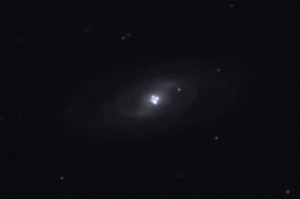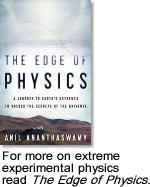Discoverer of Einstein’s Cross-John Huchra-dies unexpectedly

Celebrated astronomer and Harvard University professor John Huchra died unexpectedly on Friday, 8 October. He was 61.
Huchra is best known for conducting the impressive CfA Redshift Survey, on which he collaborated with astronomer Margaret Geller. The survey, which mapped out the large-scale structure of the universe, found a giant wall of galaxies that spanned across 500 million light years. The universe, they found, is made of giant voids, or bubbles of empty space, with galaxies clustering on the surface of these bubbles.
Huchra also has a very intriguing object named after him: a spectacular object known as Huchra’s Lens, also called Einstein’s Cross (see this link for a high resolution image).
I interviewed Huchra by email for my book The Edge of Physics. Here is an excerpt from the book (slightly edited) describing Huchra’s discovery of the eponymous gravitational lens.
The Einstein Cross is one of the more celebrated examples of gravitational lensing. It, too, was discovered unexpectedly, in 1985, by astronomer John Huchra of the Harvard-Smithsonian Center for Astrophysics, in Cambridge, Massachusetts. Huchra and colleague Margaret Geller and their team were measuring the velocities of eighteen thousand bright galaxies in the northern sky. The farthest galaxy in their study was about 700 million light-years away. One night, Huchra was observing with a 4.5-meter telescope on Mount Hopkins, about 30 miles south of Tucson, Arizona, when his technician, who was observing with a smaller telescope, called. He had found a galaxy with a spectrum that did not make sense. Huchra observed it with a better instrument and immediately recognized it as a quasar. But there was a problem. Quasars, which are the universe’s brightest objects, are from a very distant past; they lie far beyond the regions that Huchra’s team was studying and shouldn’t have shown up in the observations. Sure enough, when Huchra examined the spectrum and its redshift, he realized that the quasar was nearly 8 billion light-years away. Something very strange was going on.
There was yet another mystery surrounding the unusual object. When Huchra studied the spectrum at the center of the object, he detected a galaxy that was only about 500 million light-years away. Whatever they had found seemed to be a mixture of a nearby galaxy and an astonishingly distant quasar. More observations followed, and the astronomers realized that they were probably staring at a gravitational lens.
It was caused by a phenomenon predicted by Einstein’s general theory of relativity—the bending of light from a distant object by the gravitational field of a massive galaxy in the foreground: five bright blobs, one at the center and the four others positioned at the corners of an imaginary cross. The blobs were actually a quasar, which is a giant galaxy with a supermassive black hole at its center.


0 comments
Kick things off by filling out the form below.
You must log in to post a comment.